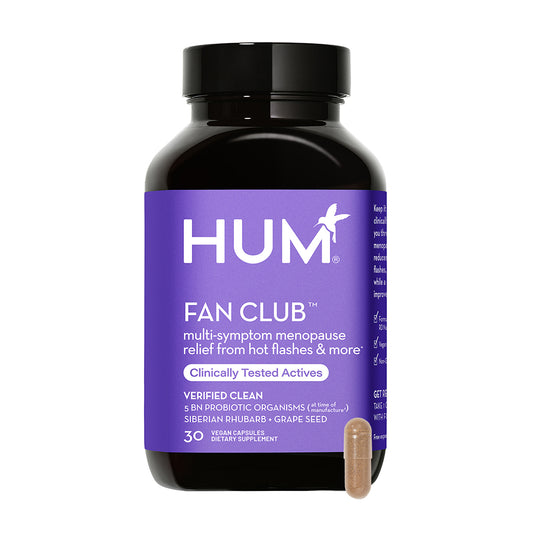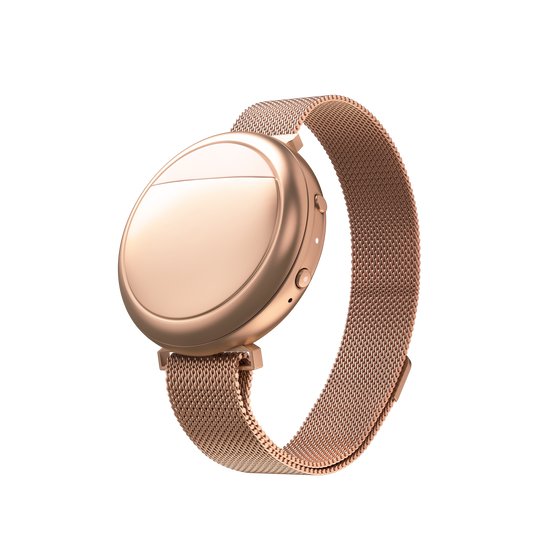Have you ever woken up drenched in sweat in the middle of the night, or felt a sudden wave of heat during an important meeting? Three out of four people who go through perimenopause and menopause have these symptoms, also referred to as vasomotor symptoms. They can make even the simplest moments difficult.
Vasomotor symptoms are more than just an annoying symptom. They impact a person’s quality of life and are associated with long-term health consequences. If they’re affecting your life, make treating them a priority.
What are hot flashes and night sweats?
Hot flashes and night sweats are some of the most common and often frustrating symptoms of perimenopause and menopause. They can make you feel uncomfortable, disrupt your sleep, drain your energy, and affect your daily life in significant ways.
These symptoms are the same physiologic process, with the only difference being the time of day they occur. Hot flashes occur while you’re awake and night sweats occur while you’re sleeping. Whether you’re wide awake or fast asleep, when your body feels like it’s overheating, it deploys a cooling response in the form of sweating.
How does temperature regulation in the body work?
Temperature regulation, or thermoregulation, is a complex process managed by the hypothalamus, a small part of your brain that works like your body’s thermostat. The hypothalamus monitors your body's core temperature and triggers responses to keep it within a narrow range, typically around 98.6°F (37°C).
When you’re too hot, it signals the body to sweat, which cools the skin and, in turn, your body. When you’re too cold, it triggers shivering and narrows your blood vessels to create heat and reduce heat loss.

Why is temperature regulation important?
Keeping your body temperature stable is crucial for your health and how your body functions. A stable temperature keeps your cells working properly, which is essential for survival. It’s especially important for your internal organs and core systems, including your heart, lungs, brain, kidneys, and digestive system.
When your temperature is steady, you feel more comfortable, alert, and energetic. But when it fluctuates, you can experience discomfort, fatigue, and even health issues like dehydration.
What causes temperature changes during perimenopause and menopause?
During perimenopause and menopause, your body goes through big hormone changes. Estrogen levels fluctuate and eventually decrease. The reason hot flashes occur is still not fully understood and complex. But there are a few things we do know.
Estrogen plays a role in the area of the hypothalamus that controls body temperature. When’s there’s enough estrogen present, that area of the hypothalamus remains in balance. When estrogen levels drop, it’s harder for that part of the hypothalamus to remain in balance and can lead to hot flashes occurring.
Another factor might be increased activity in the part of your nervous system that controls automatic functions like heart rate and blood pressure. This increased activity narrows the range of temperatures your body can handle without reacting (the thermoneutral zone), making you more susceptible to sudden heart or cold. Additionally, as you get older, your body can’t get rid of heat as well, so it’s harder to cool down.
The impact of temperature changes on your life
Temperature changes during perimenopause and menopause can have a wide-ranging impact on your daily life.

Sleep
Hot flashes and night sweats can affect sleep in different ways. Sometimes, you might not even realize you’re having a hot flash at night because it doesn’t wake you up. But even if you don’t fully wake up, these hot flashes can still disrupt your deep sleep, leaving you feeling groggy and unrested.
Night sweats can be even more frustrating. They can wake you up multiple times throughout the night, making it hard to get the restful sleep you need. Not getting enough quality sleep can leave you feeling irritable, affect your memory and decision-making, and even contribute to weight gain and decreased bone health.
Daily activities
Hot flashes and cold sweats can occur at inopportune times, like during a meeting or a social event. They can make you feel embarrassed and uncomfortable. This can make you feel less confident and social, which could make you feel more alone. The constant need to adjust your clothing or find a cooler environment can also be frustrating and time-consuming.
Emotional well-being
The discomfort and unpredictability of hot flashes and night sweats can cause stress and anxiety. Some people feel a loss of control over their bodies, which can be equally frustrating. It's important to know that these symptoms are common during the menopausal transition. Seek support and strategies to manage them.
Non-medicinal ways to help manage temperature
While medical treatments are available, many people prefer non-medicinal approaches to managing temperature changes. Below are some strategies that may help you. Talk to a healthcare professional if you have any questions or concerns.

Clinical hypnosis and cognitive behavioral therapy (CBT)
Clinical hypnosis and CBT are methods that can help manage temperature changes by reducing the stress and anxiety that often come with these symptoms. They can help reduce both the frequency and severity of vasomotor symptoms.
- Clinical hypnosis. Hypnosis can help reduce the frequency and intensity of hot flashes by helping you relax and lower stress. A trained hypnotherapist can guide you through relaxation techniques and visualization exercises.
- Cognitive behavioral therapy (CBT). CBT is a type of talk therapy that helps you identify and change negative thought patterns and actions. It can be effective in helping you manage the emotional impact of temperature changes, develop ways to cope, and feel less anxious in addition to reducing the number and intensity of the hot flashes.
Simple lifestyle changes
Applying cooling or warming to specific parts of your body
One of the most practical ways to regulate body temperature is by applying cooling or warming to specific parts of the body. This can help provide relief if you’re experiencing minor or moderate hot flashes.
- Cooling the face and neck. These areas are highly sensitive and can quickly respond to cooling. Use a cold compress or a cooling towel to help reduce the intensity of a hot flash.
- Cooling the hands and feet. Soaking your hands or feet in cold water or using cooling gloves and socks can help lower your overall body temperature.
- Warming the core. If you have cold flashes, warming your core may help. Use a heating pad or a warm blanket on your abdomen or back to feel more comfortable. Be sure to remove any wet or sweat-drenched clothing.

Other simple lifestyle changes can also help you manage mild symptoms from temperature changes.
- Fans and heating devices. Use a fan, whether it's a small desk fan or a whole-room fan, to circulate air and provide a cooling effect. Space heaters, heating pads, or heated blankets can help you feel more comfortable.
- Wearable devices. Hot flashes or chills often hit when you can’t sit in front of a fan or heater. Wearable devices, like neck fans or wristbands that cool or warm, can help you control your temperature while you’re out and about.
- Layers of clothing. Dress in layers so you can adjust your clothing based on your body's temperature. Choose light, airy fabrics like cotton or bamboo. Avoid synthetic materials that can trap heat.
Temperature changes during perimenopause and menopause are normal, but can be tough. Take proactive steps to manage them and feel more comfortable. Try cooling or warming your body, clinical hypnosis, CBT, or simple lifestyle changes. You’re not alone and support is available.
If your symptoms are interfering with your daily life, prescription medications may be the most effective option to help manage your hot flashes and night sweats. Check out Hot Flashes and Night Sweats 101 and talk to your doctor about what might work best for you.
FAQs
How do hot flashes and night sweats impact sleep?
Night sweats can wake you up multiple times during the night, making it hard to get restful sleep. This can leave you feeling irritable and foggy-headed the next day. Over time, it can affect your memory, decision-making, and even lead to weight gain and decreased bone health.
What are the effects of temperature changes on daily activities?
Hot flashes and cold sweats can strike at the worst times, making you feel embarrassed and uncomfortable. This can affect your confidence, make social situations awkward, and make you feel more alone. Constantly adjusting your clothing or finding a cooler (or warmer) spot can be frustrating and disruptive.
How can clinical hypnosis help manage temperature changes?
Clinical hypnosis can help manage hot flashes by helping you relax and feel less stressed. This can make your hot flashes less frequent and intense. A trained hypnotherapist can guide you through relaxation techniques and visualization exercises to help you stay calm and in control.
What simple lifestyle changes can help manage temperature changes?
To feel more comfortable with temperature changes, use fans or heating devices, wear cooling or warming wristbands or neck wraps, and dress in layers with breathable fabrics. If symptoms interrupt your daily life, seek help from a clinician and consider prescription therapies.
References
Balmain, B.N., Sabapathy, S., Louis, M., & Morris, N.R. (2018). Aging and thermoregulatory control: The clinical implications of exercising under heat stress in older individuals. BioMed Research International, 2018: 8306154. doi: 10.1155/2018/8306154
Beker, B.M., Cervellera, C., De Vito, A., & Musso, C.G. (2018). Human physiology in extreme heat and cold. International Archives of Clinical Physiology, 1: 001. doi.org/10.23937/iacph-2017/1710001
Composto, J., Leichman, E.S., Luedtke, K., & Mindell, J.A. (2021). Thermal comfort intervention for hot-flash related insomnia symptoms in perimenopausal and postmenopausal-aged women: An exploratory study. Behavioral Sleep Medicine, 19(1): 38-47. doi: 10.1080/15402002.2019.1699100
Fitzpatrick, L.A. & Santen, R.J. (2002). Hot flashes: The old and the new, what is really true? Mayo Clinic Proceedings, 77(11): 1155-1158. DOI: 10.4065/77.11.1155
Forma, E., Urbanska, K., & Brys, M. (2024). Menopause hot flashes and molecular mechanisms modulated by food-derived nutrients. Nutrients, 16(5): 655. https://doi.org/10.3390/nu16050655
Freedman, R.R. (2013). Menopausal hot flashes: Mechanisms, endocrinology, treatment. Journal of Steroid Biochemistry and Molecular Biology, 142: 115-120. doi: 10.1016/j.jsbmb.2013.08.010
Luo, M., Wang, Z., Zhang, H., Arens, E., Filingeri, D., Jin, L., Ghahramani, A., Chen, W., He, Y., & Si, B. (2020). High-density thermal sensitivity maps of the human body. Building and Environment, 167: 106435. Doi: 10.1016/j.buildenv.2019.106435
Muñiz, V., Padilla, V.J., Alldredge, C.T., & Elkins, G. (2025). Clinical hypnosis and cognitive behavioral therapy for hot flashes: A scoping review. Women’s Health Reports, 6(1): 1-20. doi: 10.1089/whr.2024.0144
National Institute on Aging. (2021). Hot flashes: What can I do? Accessed 6/6/2025 from https://www.nia.nih.gov/health/menopause/hot-flashes-what-can-i-do
Osilla, E.V., Marsidi, J.L., Shumway, K.R., & Sharma, S. (2023). Physiology, temperature regulation. In: StatPearls [Internet]. Treasure Island (FL): StatPearls Publishing; 2025 Jan-. Accessed 6/6/2025 from https://www.ncbi.nlm.nih.gov/books/NBK507838/
Song, W., Zhang, Z., Chen, Z., Wang, F., & Yang, B. (2022). Thermal comfort and energy performance of personal comfort systems (PCS): A systematic review and meta-analysis. Energy and Buildings, 256: 111747. https://doi.org/10.1016/j.enbuild.2021.111747
The 2023 Nonhormone therapy position statement of The North American Menopause Society Advisory Panel. (2023). The 2023 nonhormone therapy position statement of The North American Menopause Society. Menopause, 30(6): 573-590. DOI: 10.1097/GME.0000000000002200
Wang, Z., Warren, K., Luo, M., He, X., Zhang, H., Arens, E., Chen, W., He, Y., Hu, Y., Jin, L., Liu, S., Cohen-Tanugi, D., & Smith, M.J. (2020). Evaluating the comfort of thermally dynamic wearable devices. Building and Environment, 167: 106443. https://doi.org/10.1016/j.buildenv.2019.106443





